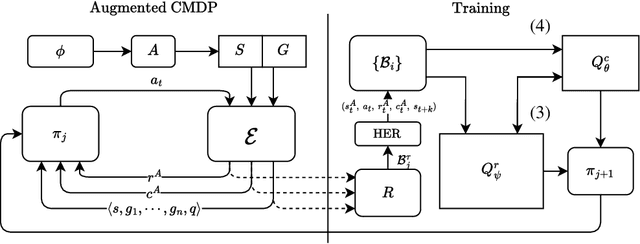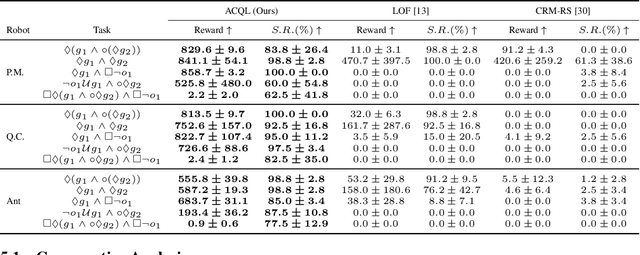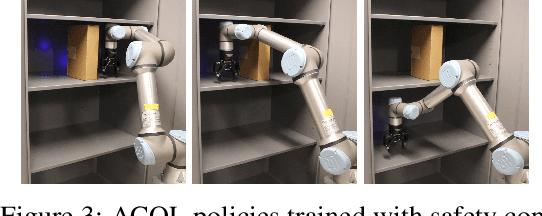Ahmed H. Qureshi
Automaton Constrained Q-Learning
Oct 06, 2025



Abstract:Real-world robotic tasks often require agents to achieve sequences of goals while respecting time-varying safety constraints. However, standard Reinforcement Learning (RL) paradigms are fundamentally limited in these settings. A natural approach to these problems is to combine RL with Linear-time Temporal Logic (LTL), a formal language for specifying complex, temporally extended tasks and safety constraints. Yet, existing RL methods for LTL objectives exhibit poor empirical performance in complex and continuous environments. As a result, no scalable methods support both temporally ordered goals and safety simultaneously, making them ill-suited for realistic robotics scenarios. We propose Automaton Constrained Q-Learning (ACQL), an algorithm that addresses this gap by combining goal-conditioned value learning with automaton-guided reinforcement. ACQL supports most LTL task specifications and leverages their automaton representation to explicitly encode stage-wise goal progression and both stationary and non-stationary safety constraints. We show that ACQL outperforms existing methods across a range of continuous control tasks, including cases where prior methods fail to satisfy either goal-reaching or safety constraints. We further validate its real-world applicability by deploying ACQL on a 6-DOF robotic arm performing a goal-reaching task in a cluttered, cabinet-like space with safety constraints. Our results demonstrate that ACQL is a robust and scalable solution for learning robotic behaviors according to rich temporal specifications.
Online Hierarchical Policy Learning using Physics Priors for Robot Navigation in Unknown Environments
Oct 01, 2025Abstract:Robot navigation in large, complex, and unknown indoor environments is a challenging problem. The existing approaches, such as traditional sampling-based methods, struggle with resolution control and scalability, while imitation learning-based methods require a large amount of demonstration data. Active Neural Time Fields (ANTFields) have recently emerged as a promising solution by using local observations to learn cost-to-go functions without relying on demonstrations. Despite their potential, these methods are hampered by challenges such as spectral bias and catastrophic forgetting, which diminish their effectiveness in complex scenarios. To address these issues, our approach decomposes the planning problem into a hierarchical structure. At the high level, a sparse graph captures the environment's global connectivity, while at the low level, a planner based on neural fields navigates local obstacles by solving the Eikonal PDE. This physics-informed strategy overcomes common pitfalls like spectral bias and neural field fitting difficulties, resulting in a smooth and precise representation of the cost landscape. We validate our framework in large-scale environments, demonstrating its enhanced adaptability and precision compared to previous methods, and highlighting its potential for online exploration, mapping, and real-world navigation.
Continuous-Time Value Iteration for Multi-Agent Reinforcement Learning
Sep 11, 2025Abstract:Existing reinforcement learning (RL) methods struggle with complex dynamical systems that demand interactions at high frequencies or irregular time intervals. Continuous-time RL (CTRL) has emerged as a promising alternative by replacing discrete-time Bellman recursion with differential value functions defined as viscosity solutions of the Hamilton--Jacobi--Bellman (HJB) equation. While CTRL has shown promise, its applications have been largely limited to the single-agent domain. This limitation stems from two key challenges: (i) conventional solution methods for HJB equations suffer from the curse of dimensionality (CoD), making them intractable in high-dimensional systems; and (ii) even with HJB-based learning approaches, accurately approximating centralized value functions in multi-agent settings remains difficult, which in turn destabilizes policy training. In this paper, we propose a CT-MARL framework that uses physics-informed neural networks (PINNs) to approximate HJB-based value functions at scale. To ensure the value is consistent with its differential structure, we align value learning with value-gradient learning by introducing a Value Gradient Iteration (VGI) module that iteratively refines value gradients along trajectories. This improves gradient fidelity, in turn yielding more accurate values and stronger policy learning. We evaluate our method using continuous-time variants of standard benchmarks, including multi-agent particle environment (MPE) and multi-agent MuJoCo. Our results demonstrate that our approach consistently outperforms existing continuous-time RL baselines and scales to complex multi-agent dynamics.
Physics-informed Neural Motion Planning via Domain Decomposition in Large Environments
Jun 15, 2025Abstract:Physics-informed Neural Motion Planners (PiNMPs) provide a data-efficient framework for solving the Eikonal Partial Differential Equation (PDE) and representing the cost-to-go function for motion planning. However, their scalability remains limited by spectral bias and the complex loss landscape of PDE-driven training. Domain decomposition mitigates these issues by dividing the environment into smaller subdomains, but existing methods enforce continuity only at individual spatial points. While effective for function approximation, these methods fail to capture the spatial connectivity required for motion planning, where the cost-to-go function depends on both the start and goal coordinates rather than a single query point. We propose Finite Basis Neural Time Fields (FB-NTFields), a novel neural field representation for scalable cost-to-go estimation. Instead of enforcing continuity in output space, FB-NTFields construct a latent space representation, computing the cost-to-go as a distance between the latent embeddings of start and goal coordinates. This enables global spatial coherence while integrating domain decomposition, ensuring efficient large-scale motion planning. We validate FB-NTFields in complex synthetic and real-world scenarios, demonstrating substantial improvements over existing PiNMPs. Finally, we deploy our method on a Unitree B1 quadruped robot, successfully navigating indoor environments. The supplementary videos can be found at https://youtu.be/OpRuCbLNOwM.
Dynamic Robot Tool Use with Vision Language Models
May 02, 2025Abstract:Tool use enhances a robot's task capabilities. Recent advances in vision-language models (VLMs) have equipped robots with sophisticated cognitive capabilities for tool-use applications. However, existing methodologies focus on elementary quasi-static tool manipulations or high-level tool selection while neglecting the critical aspect of task-appropriate tool grasping. To address this limitation, we introduce inverse Tool-Use Planning (iTUP), a novel VLM-driven framework that enables grounded fine-grained planning for versatile robotic tool use. Through an integrated pipeline of VLM-based tool and contact point grounding, position-velocity trajectory planning, and physics-informed grasp generation and selection, iTUP demonstrates versatility across (1) quasi-static and more challenging (2) dynamic and (3) cluster tool-use tasks. To ensure robust planning, our framework integrates stable and safe task-aware grasping by reasoning over semantic affordances and physical constraints. We evaluate iTUP and baselines on a comprehensive range of realistic tool use tasks including precision hammering, object scooping, and cluster sweeping. Experimental results demonstrate that iTUP ensures a thorough grounding of cognition and planning for challenging robot tool use across diverse environments.
Implicit Physics-aware Policy for Dynamic Manipulation of Rigid Objects via Soft Body Tools
Feb 08, 2025



Abstract:Recent advancements in robot tool use have unlocked their usage for novel tasks, yet the predominant focus is on rigid-body tools, while the investigation of soft-body tools and their dynamic interaction with rigid bodies remains unexplored. This paper takes a pioneering step towards dynamic one-shot soft tool use for manipulating rigid objects, a challenging problem posed by complex interactions and unobservable physical properties. To address these problems, we propose the Implicit Physics-aware (IPA) policy, designed to facilitate effective soft tool use across various environmental configurations. The IPA policy conducts system identification to implicitly identify physics information and predict goal-conditioned, one-shot actions accordingly. We validate our approach through a challenging task, i.e., transporting rigid objects using soft tools such as ropes to distant target positions in a single attempt under unknown environment physics parameters. Our experimental results indicate the effectiveness of our method in efficiently identifying physical properties, accurately predicting actions, and smoothly generalizing to real-world environments. The related video is available at: https://youtu.be/4hPrUDTc4Rg?si=WUZrT2vjLMt8qRWA
Differentiable Composite Neural Signed Distance Fields for Robot Navigation in Dynamic Indoor Environments
Feb 04, 2025Abstract:Neural Signed Distance Fields (SDFs) provide a differentiable environment representation to readily obtain collision checks and well-defined gradients for robot navigation tasks. However, updating neural SDFs as the scene evolves entails re-training, which is tedious, time consuming, and inefficient, making it unsuitable for robot navigation with limited field-of-view in dynamic environments. Towards this objective, we propose a compositional framework of neural SDFs to solve robot navigation in indoor environments using only an onboard RGB-D sensor. Our framework embodies a dual mode procedure for trajectory optimization, with different modes using complementary methods of modeling collision costs and collision avoidance gradients. The primary stage queries the robot body's SDF, swept along the route to goal, at the obstacle point cloud, enabling swift local optimization of trajectories. The secondary stage infers the visible scene's SDF by aligning and composing the SDF representations of its constituents, providing better informed costs and gradients for trajectory optimization. The dual mode procedure combines the best of both stages, achieving a success rate of 98%, 14.4% higher than baseline with comparable amortized plan time on iGibson 2.0. We also demonstrate its effectiveness in adapting to real-world indoor scenarios.
Integrating Active Sensing and Rearrangement Planning for Efficient Object Retrieval from Unknown, Confined, Cluttered Environments
Nov 18, 2024



Abstract:Retrieving target objects from unknown, confined spaces remains a challenging task that requires integrated, task-driven active sensing and rearrangement planning. Previous approaches have independently addressed active sensing and rearrangement planning, limiting their practicality in real-world scenarios. This paper presents a new, integrated heuristic-based active sensing and Monte-Carlo Tree Search (MCTS)-based retrieval planning approach. These components provide feedback to one another to actively sense critical, unobserved areas suitable for the retrieval planner to plan a sequence for relocating path-blocking obstacles and a collision-free trajectory for retrieving the target object. We demonstrate the effectiveness of our approach using a robot arm equipped with an in-hand camera in both simulated and real-world confined, cluttered scenarios. Our framework is compared against various state-of-the-art methods. The results indicate that our proposed approach outperforms baseline methods by a significant margin in terms of the success rate, the object rearrangement planning time consumption and the number of planning trials before successfully retrieving the target. Videos can be found at https://youtu.be/tea7I-3RtV0.
Physics-informed Neural Mapping and Motion Planning in Unknown Environments
Oct 13, 2024Abstract:Mapping and motion planning are two essential elements of robot intelligence that are interdependent in generating environment maps and navigating around obstacles. The existing mapping methods create maps that require computationally expensive motion planning tools to find a path solution. In this paper, we propose a new mapping feature called arrival time fields, which is a solution to the Eikonal equation. The arrival time fields can directly guide the robot in navigating the given environments. Therefore, this paper introduces a new approach called Active Neural Time Fields (Active NTFields), which is a physics-informed neural framework that actively explores the unknown environment and maps its arrival time field on the fly for robot motion planning. Our method does not require any expert data for learning and uses neural networks to directly solve the Eikonal equation for arrival time field mapping and motion planning. We benchmark our approach against state-of-the-art mapping and motion planning methods and demonstrate its superior performance in both simulated and real-world environments with a differential drive robot and a 6 degrees-of-freedom (DOF) robot manipulator. The supplementary videos can be found at https://youtu.be/qTPL5a6pRKk, and the implementation code repository is available at https://github.com/Rtlyc/antfields-demo.
Physics-informed Neural Motion Planning on Constraint Manifolds
Mar 09, 2024Abstract:Constrained Motion Planning (CMP) aims to find a collision-free path between the given start and goal configurations on the kinematic constraint manifolds. These problems appear in various scenarios ranging from object manipulation to legged-robot locomotion. However, the zero-volume nature of manifolds makes the CMP problem challenging, and the state-of-the-art methods still take several seconds to find a path and require a computationally expansive path dataset for imitation learning. Recently, physics-informed motion planning methods have emerged that directly solve the Eikonal equation through neural networks for motion planning and do not require expert demonstrations for learning. Inspired by these approaches, we propose the first physics-informed CMP framework that solves the Eikonal equation on the constraint manifolds and trains neural function for CMP without expert data. Our results show that the proposed approach efficiently solves various CMP problems in both simulation and real-world, including object manipulation under orientation constraints and door opening with a high-dimensional 6-DOF robot manipulator. In these complex settings, our method exhibits high success rates and finds paths in sub-seconds, which is many times faster than the state-of-the-art CMP methods.
 Add to Chrome
Add to Chrome Add to Firefox
Add to Firefox Add to Edge
Add to Edge